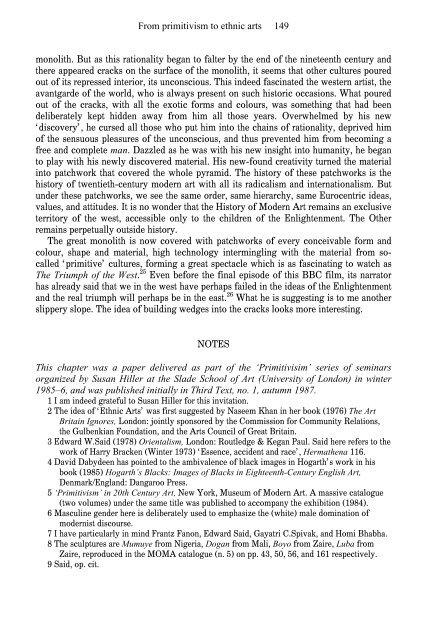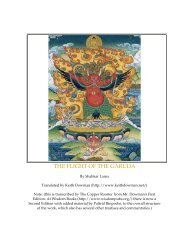Hiller - The Myth of Primitivism. Perspectives on Art - Esoteric Online
Hiller - The Myth of Primitivism. Perspectives on Art - Esoteric Online
Hiller - The Myth of Primitivism. Perspectives on Art - Esoteric Online
Create successful ePaper yourself
Turn your PDF publications into a flip-book with our unique Google optimized e-Paper software.
From primitivism to ethnic arts 149<br />
m<strong>on</strong>olith. But as this rati<strong>on</strong>ality began to falter by the end <str<strong>on</strong>g>of</str<strong>on</strong>g> the nineteenth century and<br />
there appeared cracks <strong>on</strong> the surface <str<strong>on</strong>g>of</str<strong>on</strong>g> the m<strong>on</strong>olith, it seems that other cultures poured<br />
out <str<strong>on</strong>g>of</str<strong>on</strong>g> its repressed interior, its unc<strong>on</strong>scious. This indeed fascinated the western artist, the<br />
avantgarde <str<strong>on</strong>g>of</str<strong>on</strong>g> the world, who is always present <strong>on</strong> such historic occasi<strong>on</strong>s. What poured<br />
out <str<strong>on</strong>g>of</str<strong>on</strong>g> the cracks, with all the exotic forms and colours, was something that had been<br />
deliberately kept hidden away from him all those years. Overwhelmed by his new<br />
‘discovery’, he cursed all those who put him into the chains <str<strong>on</strong>g>of</str<strong>on</strong>g> rati<strong>on</strong>ality, deprived him<br />
<str<strong>on</strong>g>of</str<strong>on</strong>g> the sensuous pleasures <str<strong>on</strong>g>of</str<strong>on</strong>g> the unc<strong>on</strong>scious, and thus prevented him from becoming a<br />
free and complete man. Dazzled as he was with his new insight into humanity, he began<br />
to play with his newly discovered material. His new-found creativity turned the material<br />
into patchwork that covered the whole pyramid. <str<strong>on</strong>g>The</str<strong>on</strong>g> history <str<strong>on</strong>g>of</str<strong>on</strong>g> these patchworks is the<br />
history <str<strong>on</strong>g>of</str<strong>on</strong>g> twentieth-century modern art with all its radicalism and internati<strong>on</strong>alism. But<br />
under these patchworks, we see the same order, same hierarchy, same Eurocentric ideas,<br />
values, and attitudes. It is no w<strong>on</strong>der that the History <str<strong>on</strong>g>of</str<strong>on</strong>g> Modern <strong>Art</strong> remains an exclusive<br />
territory <str<strong>on</strong>g>of</str<strong>on</strong>g> the west, accessible <strong>on</strong>ly to the children <str<strong>on</strong>g>of</str<strong>on</strong>g> the Enlightenment. <str<strong>on</strong>g>The</str<strong>on</strong>g> Other<br />
remains perpetually outside history.<br />
<str<strong>on</strong>g>The</str<strong>on</strong>g> great m<strong>on</strong>olith is now covered with patchworks <str<strong>on</strong>g>of</str<strong>on</strong>g> every c<strong>on</strong>ceivable form and<br />
colour, shape and material, high technology intermingling with the material from socalled<br />
‘primitive’ cultures, forming a great spectacle which is as fascinating to watch as<br />
<str<strong>on</strong>g>The</str<strong>on</strong>g> Triumph <str<strong>on</strong>g>of</str<strong>on</strong>g> the West. 25 Even before the final episode <str<strong>on</strong>g>of</str<strong>on</strong>g> this BBC film, its narrator<br />
has already said that we in the west have perhaps failed in the ideas <str<strong>on</strong>g>of</str<strong>on</strong>g> the Enlightenment<br />
and the real triumph will perhaps be in the east. 26 What he is suggesting is to me another<br />
slippery slope. <str<strong>on</strong>g>The</str<strong>on</strong>g> idea <str<strong>on</strong>g>of</str<strong>on</strong>g> building wedges into the cracks looks more interesting.<br />
NOTES<br />
This chapter was a paper delivered as part <str<strong>on</strong>g>of</str<strong>on</strong>g> the ‘Primitivisim’ series <str<strong>on</strong>g>of</str<strong>on</strong>g> seminars<br />
organized by Susan <str<strong>on</strong>g>Hiller</str<strong>on</strong>g> at the Slade School <str<strong>on</strong>g>of</str<strong>on</strong>g> <strong>Art</strong> (University <str<strong>on</strong>g>of</str<strong>on</strong>g> L<strong>on</strong>d<strong>on</strong>) in winter<br />
1985–6, and was published initially in Third Text, no. 1, autumn 1987.<br />
1 I am indeed grateful to Susan <str<strong>on</strong>g>Hiller</str<strong>on</strong>g> for this invitati<strong>on</strong>.<br />
2 <str<strong>on</strong>g>The</str<strong>on</strong>g> idea <str<strong>on</strong>g>of</str<strong>on</strong>g> ‘Ethnic <strong>Art</strong>s’ was first suggested by Naseem Khan in her book (1976) <str<strong>on</strong>g>The</str<strong>on</strong>g> <strong>Art</strong><br />
Britain Ignores, L<strong>on</strong>d<strong>on</strong>: jointly sp<strong>on</strong>sored by the Commissi<strong>on</strong> for Community Relati<strong>on</strong>s,<br />
the Gulbenkian Foundati<strong>on</strong>, and the <strong>Art</strong>s Council <str<strong>on</strong>g>of</str<strong>on</strong>g> Great Britain.<br />
3 Edward W.Said (1978) Orientalism, L<strong>on</strong>d<strong>on</strong>: Routledge & Kegan Paul. Said here refers to the<br />
work <str<strong>on</strong>g>of</str<strong>on</strong>g> Harry Bracken (Winter 1973) ‘Essence, accident and race’, Hermathena 116.<br />
4 David Dabydeen has pointed to the ambivalence <str<strong>on</strong>g>of</str<strong>on</strong>g> black images in Hogarth’s work in his<br />
book (1985) Hogarth’s Blacks: Images <str<strong>on</strong>g>of</str<strong>on</strong>g> Blacks in Eighteenth-Century English <strong>Art</strong>,<br />
Denmark/England: Dangaroo Press.<br />
5 ‘<str<strong>on</strong>g>Primitivism</str<strong>on</strong>g>’ in 20th Century <strong>Art</strong>, New York, Museum <str<strong>on</strong>g>of</str<strong>on</strong>g> Modern <strong>Art</strong>. A massive catalogue<br />
(two volumes) under the same title was published to accompany the exhibiti<strong>on</strong> (1984).<br />
6 Masculine gender here is deliberately used to emphasize the (white) male dominati<strong>on</strong> <str<strong>on</strong>g>of</str<strong>on</strong>g><br />
modernist discourse.<br />
7 I have particularly in mind Frantz Fan<strong>on</strong>, Edward Said, Gayatri C.Spivak, and Homi Bhabha.<br />
8 <str<strong>on</strong>g>The</str<strong>on</strong>g> sculptures are Mumuye from Nigeria, Dogan from Mali, Boyo from Zaire, Luba from<br />
Zaire, reproduced in the MOMA catalogue (n. 5) <strong>on</strong> pp. 43, 50, 56, and 161 respectively.<br />
9 Said, op. cit.




